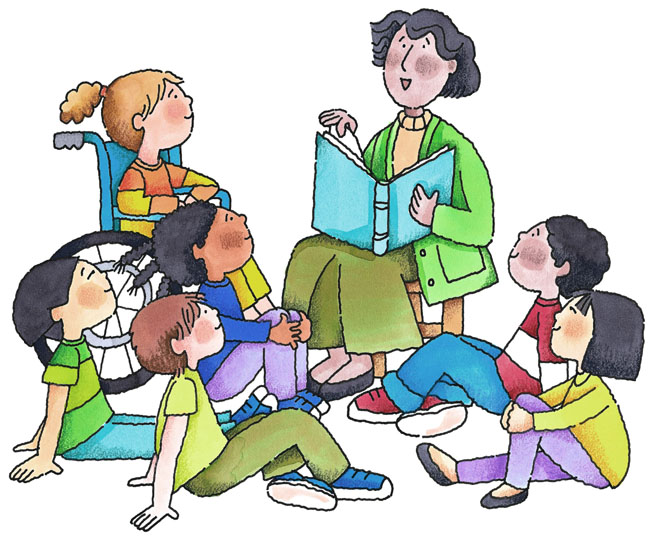Over the years I’ve heard many reasons why someone does not want to teach a Bible class. These reasons range anywhere from “I don’t have time” to “It’s time for the younger women to take over teaching class” to “That class (or sometimes even ‘that student’) is out of control”. For some of us in various times of our lives, any one of these reasons may be legitimate. I don’t want to write something to make anyone feel guilty about the reasons they do not teach Bible class, but I would like to talk about the last one…about the out of control class. I have an opinion that may not be popular:
It’s Always The Teacher’s Fault
You read it right. I said, “It’s always the teacher’s fault.” If you are a Bible class teacher and you have an unruly class, it is all your fault. You don’t agree? Give me a few minutes and maybe you will agree and hopefully, if you find yourself in an unruly classroom, you will be inspired and motivated to make your Bible class a pleasant experience for both teacher and student.
In every Bible class there are things the teacher can control and there are things the teacher has no control over. Knowing what these are and how to use them to your advantage is a good thing. The student, on the other hand, has no control over any of these things, so blaming the classroom behavior on the students is not fair. Can we blame the parents? Well…yes. They can be a huge asset to the behavior of the children but there are some who are unwilling or unavailable to teach their children proper behavior. That still does not relieve the teacher of the responsibility for the behavior of her classroom.
First let’s look at the things the teacher cannot control.
How long the class is.
This is usually determined and followed by the whole congregation. While a longer class time can be trying on young students, especially students who are not accustomed to being in a Bible class setting, it is essential for the older children and the adults to have classes long enough to adequately cover the topic they are discussing.
What is a teacher to do if she finds her class time is too long? Be Prepared!
Make sure there are enough activities, good quality activities, to keep the children busy learning the entire class time. In a toddler class this can mean about 15 activities. In a preschool class this can mean about 10 activities. The older the child, the longer the attention span so the less activities required. Ideally there should be enough activities planned so there is no down time and there are activities that will have to be saved for another day.
How many students are in class.
While we want as many students as possible to learn about God, having a class with too many children can be difficult to control. There’s nothing as stressful and at the same time as enjoyable as being prepared for 8 students and having 12 show up.
What can a teacher do when more children show up than expected? Be flexible!
If you typically have 4 regular students, it is not unreasonable to prepare for 6 or even 8. While some may look at this as being wasteful since all the material will not be used completely, I think the benefits outweigh the cost. A few extra dollars to ensure that each student feels welcome and a part of the class is not too much to ask. It might even be necessary to change up what was planned to accommodate the class size. This can even be true if only one of your students shows up. It might be better to wait until all or most of the class are in attendance to do some activities.
The ages of the students.
This is a really difficult one. If you are blessed to be in a congregation where the age range is no more than 2 years per class, consider yourself blessed. But, if you are in a congregation where the age range for the children per class spans 4 or even 6 years, you have a challenge on your hands. Keeping the older children challenged while keeping the younger children engaged is not for the faint of heart. Thankfully, these kinds of classes are typically small. If there were more children, the class would most likely be split up and then the age range would be reduced.
What is a teacher to do with a wide age range of students? Be creative!
Think outside the box. Giving the older children more responsibility. Encouraging the older children to help the younger children. Before the eye rolling starts as you sing a song or do an activity that is for younger children, tell the older ones that you need their help to teach the younger ones and this song or this activity will help them learn about God.

Now let’s look at the things a teacher can control:
Even though there are things out of the teacher’s control, there are things that can be done to improve the situation. But that’s not all that affects the behavior of the class. There are things in the teacher’s control that can greatly improve everyone’s attitude. Improving the attitude of the teacher and the attitude of the student is the key to improving classroom behavior.
The atmosphere in the room.
Every chance I get, I like to visit other Bible classrooms. When I’m visiting a congregation, don’t be surprised if you see me roaming around the classroom wing of the building, opening doors and peeking in. I like to see what other teachers are doing, how they decorate their classroom, what the class is studying. I see classrooms that are organized, unorganized, busy with lots of wall decor, streamlined with only the minimum. I see classrooms that are obviously studying the Bible and some that aren’t.
For the most part, the teacher controls what the classroom looks like. Here are a few rules I go by:
1. It’s a classroom, not a storage room. Everything in the classroom should be there for the single purpose of teaching the children about God. If it’s your turn to teach, spend a day or two in the classroom and do some house cleaning. If you have finished your time to teach, be sure to clear out anything that will not be used the next quarter. Don’t leave your stuff for someone else to clean up.
2. Keep the bulletin boards current. Bulletin boards that are never changed are a sign of a lack of interest on the teacher’s part. Many children are visual learners. I was and still am. I remember things my teacher had on the wall even if I don’t remember a thing she said. Making a policy of changing at least one bulletin board each quarter is the least a teacher can do. Is wall decor not your thing? Ask the help of someone else. This is a good way to get teenage girls involved.
3. Keep it simple. I know that different teachers have different styles. Some think that a classroom is not completely functional unless every inch of wall space is covered with a teaching activity. I personally get a little overwhelmed if there is too much going on on the walls. I like to keep things simple with solid light colors (preferably white) on the walls, bright contrasting colors on the bulletin boards. Posters or other decor that either pertains to the lessons being taught that quarter or help the students learn generic Bible topics like books of the Bible, salvation, review of previous lessons, etc.
The activities used during class.
Using appropriate activities is essential. Having an opening routine is very helpful. The activities/songs used during this time can vary a little from week to week but should follow the same basic plan. Having a routine helps set the tone for the class and helps the unruly students know what to expect.
The middle of the class should contain activities that help the student learn the lesson of the day beginning with a review of previous lessons followed by introducing the new one. There are a variety of methods that can be used to teach the lesson and all of them should be used at one time or another. I like to tell the new story 3 different ways during each class. These can be reading straight from the Bible, using a flip chart, a flannel graph, a slide show. Keeping it interesting with variety while at the same time keeping it something the students are accustomed to will help improve behavior. Introducing one new method at a time is a good idea but can make it difficult for a new teacher to the class.
The end of the class should be planned as well. Even if my class is going well up to this point, if I’m not prepared, things can get out of hand quickly. Having a routine helps here just like it does at the beginning of class. I usually let the children dictate what we do at the end but only if they have been cooperating throughout the class and only from previously approved of activities. I will says things like, “Would you like to do this, or this?” instead of saying, “What would you like to do?”
Behavior expectation.
Hopefully, after all of the above things have been taken care of, the behavior of the class will have improved, but there still may need to be a list of rules or expected behaviors. I’ve never actually written down a list of rules, although I know teachers who do this with success, but I will talk with the children about what I expect of them. It might be a gentle reminder that we don’t talk while someone else is talking. It might be a talk at the beginning of each class about what the rules are. As difficult behavior improves, fine tune the behavior by adding a new expectation.
The hard thing is consistency. It helps if the parents are consistent at home but, as mentioned earlier, it is not always what happens. It helps if all the teachers are on the same page and expect the same behavior but that, too, isn’t always possible. Consistency and love and patience, a lot of patience, is essential.
There are a few tricks that can help as well:
Kids love stickers. I’m not a sticker kind of teacher but I know that kids will do just about anything you ask if they are promised a sticker.
I like to use a light to motivate the kids. One of those battery operated tap it lights. I’ve used a battery operated candle which was cool because it tied into the well loved song This Little Light Of Mine but they aren’t as easy to use as a tap it light. I tell the kids what the rules are and that the light will stay on as long as they are following the rules. The kids do not like to see the light go off. They will use positive peer pressure to insure that the light stays on.
Other things I’ve done include pausing in whatever we’re doing to wait on the offending child to behave…as long as it takes. This works as long as the child is not completely out of control and is old enough to understand why I’ve stopped talking.
If a child is not listening to me, I will insist he look me in the eyes. If he turns away, even a little, I stop until he makes eye contact again. This takes patience on my part but lets the child know I mean what I say.
Taking privileges away. Losing turns. I even have been known to take a chair away and have the student stand until the behavior improves. All of these work with some kids, not with others and should be used sparingly.
Back to our original thought:
It’s Always The Teacher’s Fault.
If the teacher has used her creativity in preparing for the class and has realized that flexibility is important, if the classroom is inviting without being overstimulating, if the activities are age appropriate and there are enough to keep the children’s minds and hands occupied and if the student understands the class rules and knows that the penalties and rewards will be consistently carried out, behavior should, if not be amazing, at least be improved. So before you hesitate teaching a class because it is rowdy or out of control, remember it’s not the students’ fault. They have no control over anything going on in the classroom. They will behave according to the expectation and consistency of the adult in charge.








Thank you for this important information. I knew of a preschool class that I had taught and had no problems with, others had taught and had no problems, then one day one of the men heard bagging on a door and kids running wild in the class. He opened the door to check what was happening and the teacher blamed the troubles on the children in the class, but they had never acted that way before. In fact all the children sat still, sang, did their craft,and followed the routine of the class and rarely had any troubles at all before this one teacher. The next teacher never had problems with the children either. To this day I don’t know how she let things get so out of hand. At the time I tried to nicely talk to her about some of these things and the necessity of having control in the classroom.
Your example just goes to show how important the teacher’s role in the class is. Children left to themselves without sufficient supervision or activities will turn wild in a heart beat. As we read in Proverbs: Foolishness is bound up in the heart of a child. Prov. 22:15
Like the scout motto: Be prepared!
:)